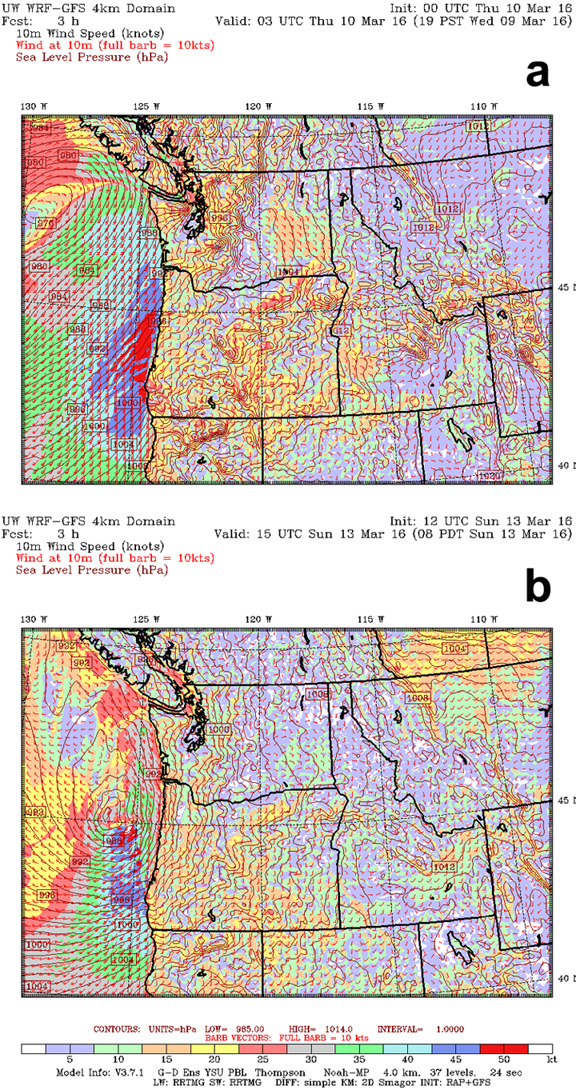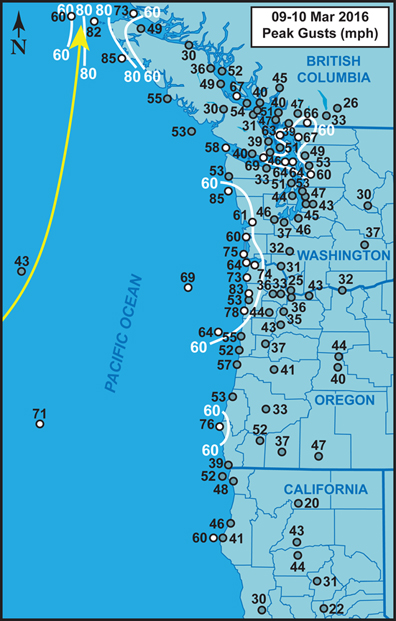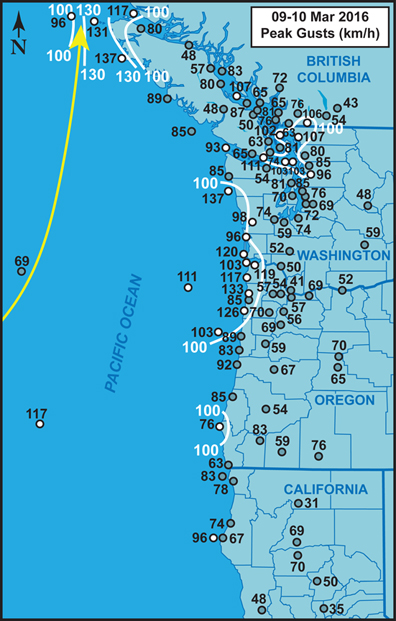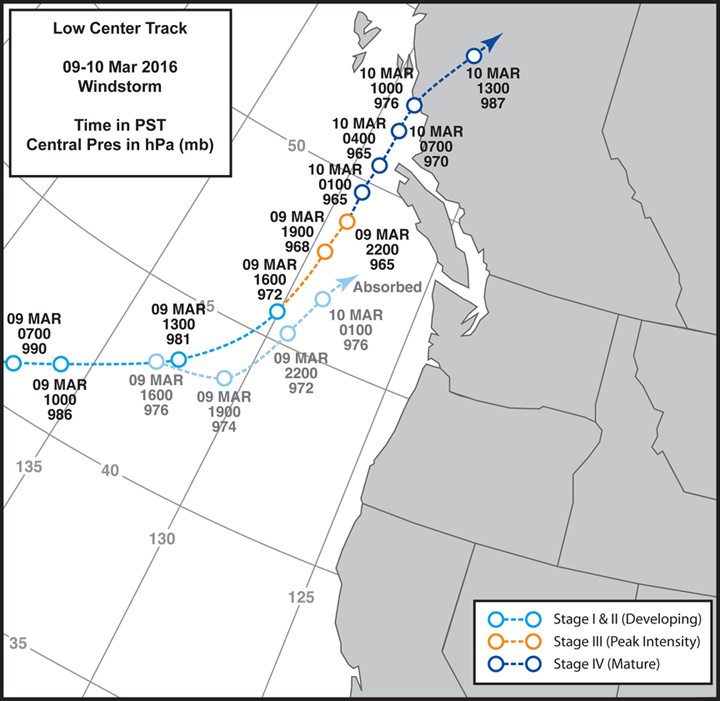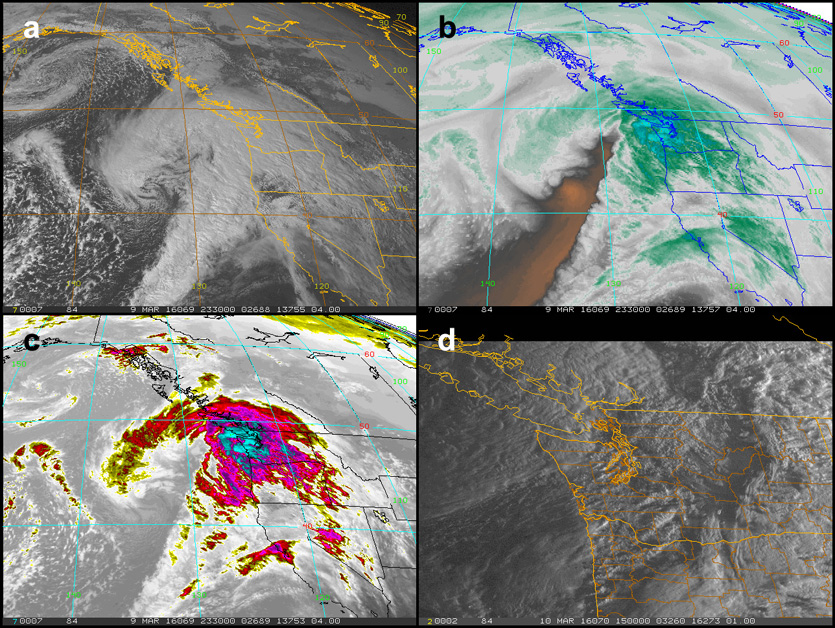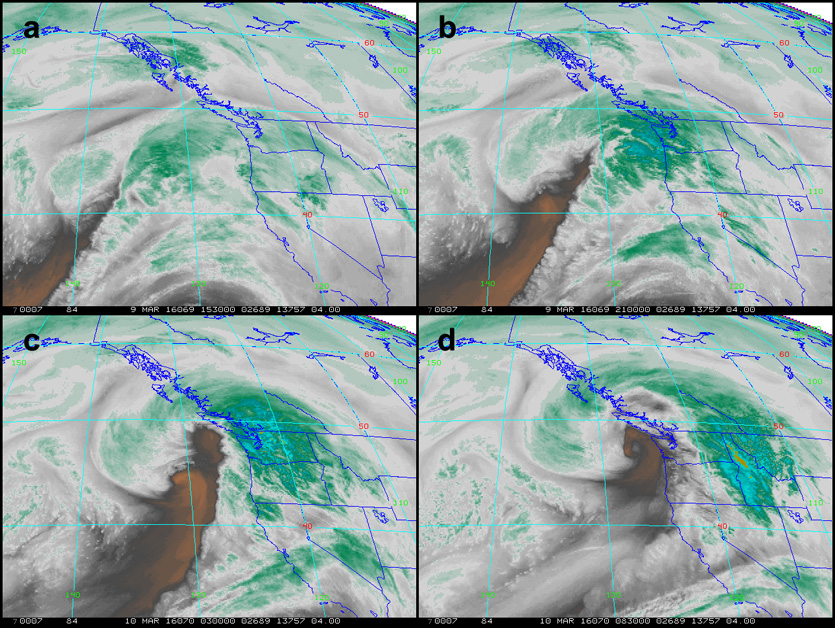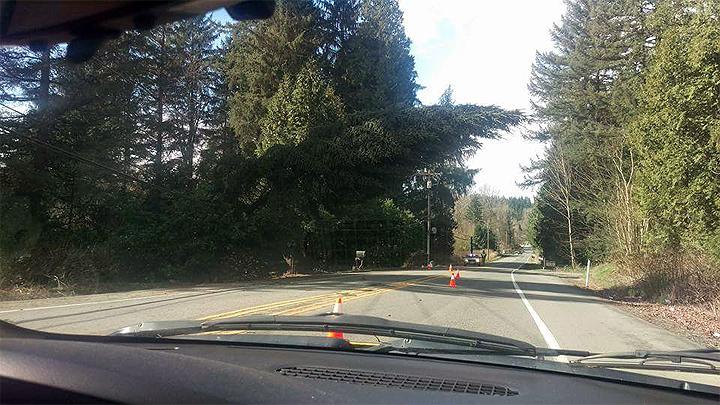
| Location |
Latitude (ºN) |
Peak Wind (2-min) |
Peak Gust (3 or 5-sec) |
| Direct (°) |
Speed (kt) |
Speed (mph) |
Speed (km/h) |
Time (PST) |
Day (PST) |
Direct (°) |
Speed (kt) |
Speed (mph) |
Speed (km/h) |
Time (PST) |
Day (PST) |

| Coast |
|
|
|
|
|
|
|
|
|
|
|
|
|
| KACV |
40.98 |
180 |
26 |
30 |
48 |
1453 |
9 |
200 |
40 |
46 |
74 |
1509 |
9 |
| KCEC |
41.78 |
190 |
31 |
36 |
57 |
2209 |
9 |
180 |
42 |
48 |
78 |
2204 |
9 |
| KOTH |
43.42 |
190 |
27 |
31 |
50 |
1735 |
9 |
170 |
46 |
53 |
85 |
1815 |
9 |
| KONP |
44.58 |
210 |
33 |
38 |
61 |
2255 |
9 |
190 |
48 |
55 |
89 |
1655 |
9 |
| KAST |
46.16 |
190 |
36 |
41 |
67 |
1955 |
9 |
220 |
64 |
74 |
119 |
1904 |
9 |
| KHQM |
46.97 |
160 |
38 |
44 |
70 |
1853 |
9 |
160 |
53 |
61 |
98 |
2132 |
9 |
| KUIL |
47.94 |
180 |
26 |
30 |
48 |
0353 |
10 |
180 |
46 |
53 |
85 |
0353 |
10 |
| 46087 |
48.49 |
179 |
40 |
46 |
75 |
0540 |
10 |
170 |
51 |
58 |
94 |
0532 |
10 |
| CWEB |
49.38 |
150 |
39 |
45 |
72 |
2200 |
9 |
160 |
48 |
55 |
89 |
2147 |
9 |
|
|
|
|
|
|
|
|
|
|
|
|
|
|
| Coast Max |
210 |
40 |
46 |
75 |
|
|
220 |
64 |
74 |
119 |
|
|
| Coast Min |
150 |
26 |
30 |
48 |
|
|
160 |
40 |
46 |
74 |
|
|
|
|
|
|
|
|
|
|
|
|
|
|
AGR |
|
| Coast Avg |
180 |
32.9 |
37.9 |
61 |
|
|
182 |
48.6 |
55.9 |
90 |
1.48 |
|
|
|
|
|
|
|
|
|
|
|
|
|
|
|
| |
|
|
|
|
|
|
|
|
|
|
|
|
|
| Interior |
|
|
|
|
|
|
|
|
|
|
|
|
|
| KRBL |
40.15 |
160 |
26 |
30 |
48 |
0054 |
10 |
150 |
38 |
44 |
70 |
0811 |
10 |
| KMFR |
42.38 |
150 |
23 |
26 |
43 |
1853 |
9 |
150 |
32 |
37 |
59 |
1808 |
9 |
| KRBG |
43.23 |
180 |
16 |
18 |
30 |
1553 |
9 |
160 |
22 |
25 |
41 |
1552 |
9 |
| KEUG |
44.13 |
230 |
24 |
28 |
44 |
0013 |
10 |
220 |
36 |
41 |
67 |
0127 |
10 |
| KSLE |
44.91 |
210 |
20 |
23 |
37 |
0056 |
10 |
190 |
37 |
43 |
69 |
0026 |
10 |
| KPDX |
45.60 |
110 |
20 |
23 |
37 |
1353 |
9 |
200 |
31 |
36 |
57 |
0405 |
10 |
| KKLS |
46.12 |
180 |
15 |
17 |
28 |
0055 |
10 |
160 |
27 |
31 |
50 |
1935 |
9 |
| KOLM |
46.97 |
180 |
20 |
23 |
37 |
2254 |
9 |
210 |
32 |
37 |
59 |
0339 |
10 |
| KSEA |
47.44 |
190 |
24 |
28 |
44 |
0853 |
10 |
170 |
39 |
45 |
72 |
0526 |
10 |
| KNUW |
48.35 |
170 |
39 |
45 |
72 |
0356 |
10 |
170 |
56 |
64 |
104 |
0358 |
10 |
| KBLI |
48.80 |
150 |
36 |
41 |
67 |
0453 |
10 |
150 |
58 |
67 |
107 |
0353 |
10 |
| CYYJ |
48.64 |
230 |
18 |
21 |
33 |
1332 |
10 |
200 |
34 |
39 |
63 |
2100 |
9 |
| CYVR |
49.03 |
150 |
24 |
28 |
44 |
0700 |
10 |
170 |
35 |
40 |
65 |
0700 |
10 |
| CYXX |
49.18 |
170 |
36 |
41 |
67 |
0900 |
10 |
170 |
57 |
66 |
106 |
0900 |
10 |
| CYQQ |
49.72 |
140 |
32 |
37 |
59 |
0614 |
10 |
150 |
43 |
49 |
80 |
0614 |
10 |
|
|
|
|
|
|
|
|
|
|
|
|
|
|
| Interior Max |
230 |
39 |
45 |
72 |
|
|
220 |
58 |
67 |
107 |
|
|
| Interior Min |
110 |
15 |
17 |
28 |
|
|
150 |
22 |
25 |
41 |
|
|
|
|
|
|
|
|
|
|
|
|
|
|
AGR |
|
| Interior Avg |
170 |
24.9 |
28.6 |
46 |
|
|
173 |
38.5 |
44.3 |
71 |
1.55 |
|
|
|
|
|
|
|
|
|
|
|
|
|
|
|
| Coast/Interior Avgs |
1.06 |
1.32 |
|
|
|
|
1.05 |
1.26 |
|
|
|
|
|
|
|
|
|
|
|
|
|
|
|
|
|
|
| 24-Sta Max |
230 |
40 |
46 |
75 |
|
|
220 |
64 |
74 |
119 |
|
|
| 24-Sta Min |
110 |
15 |
17 |
28 |
|
|
150 |
22 |
25 |
41 |
|
|
|
|
|
|
|
|
|
|
|
|
|
|
AGR |
|
| 11-Sta Avg |
173 |
28.1 |
32.4 |
52.1 |
|
|
177 |
42.5 |
48.9 |
78.6 |
1.51 |
|
| 24-Sta Avg |
175 |
28.5 |
32.7 |
52.7 |
|
|
177 |
43.2 |
49.7 |
80.1 |
1.52 |
|

| Peak Wind/Gust Table Notes |
| Peak wind as reported in the hourly and special observations, to keep consistency with earlier records. |
| Wind is a 2-minute average for all listed stations, save for some NDBC platforms. |
| Gust for US stations is a 3-second (s) average, save TTIW1/46087 which is a 5-s average. Canadian gust is 3-s. |
| YVR, YYJ, YXX and YQQ peak gust from the daily data. Timing based on peak in the hourly and special obs. |
| Buoy 46087 is used in place of TTIW1 as the latter stopped reporting wind in early 2014. |
Table 3.1 above For 24 key stations in the study region, peak wind and gust (knots, mph and km/h), with direction (º) and time of occurrence (PST). Regional and overall maximums, minimums and averages are provided, along with the legacy 11-station average. Average gust ratios (average wind/average gust), or AGR, are also included. Wind direction average is based on vector components.
|
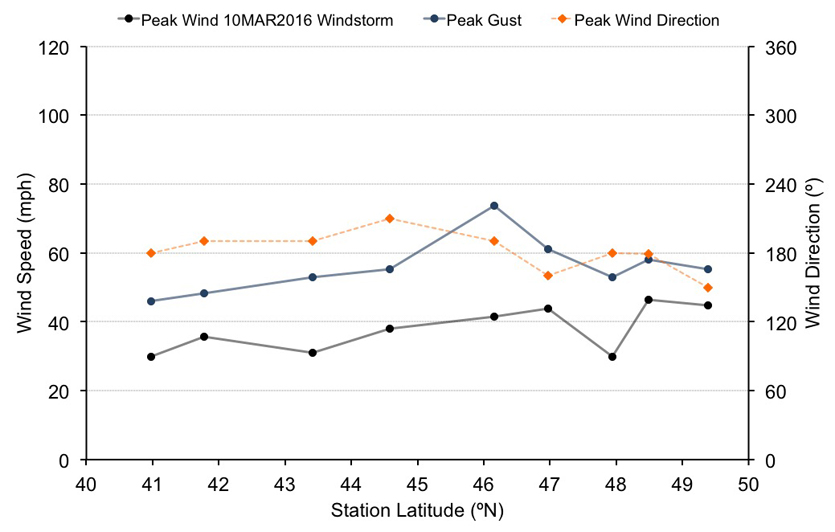
Figure 3.1 above Peak wind (mph), peak gust and peak wind direction (º) for coastal stations arranged by latitude.
|
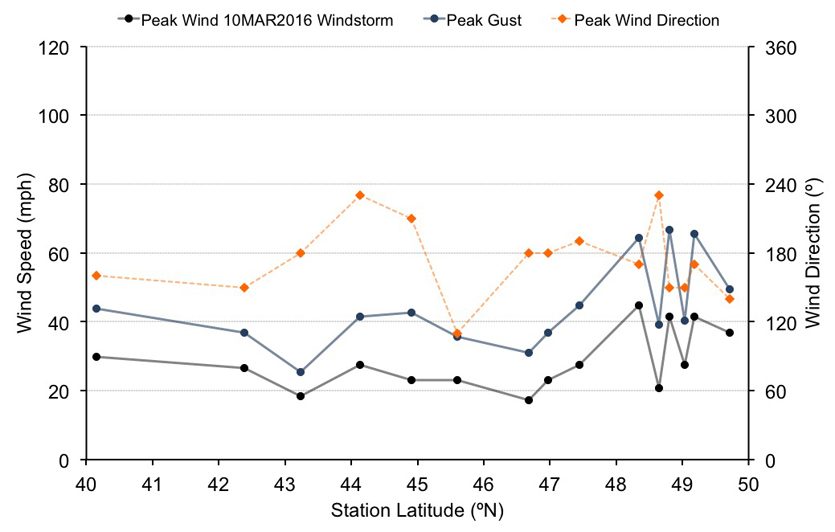
Figure 3.2 above Peak wind (mph), peak gust and peak wind direction (º) for interior stations arranged by latitude.
|
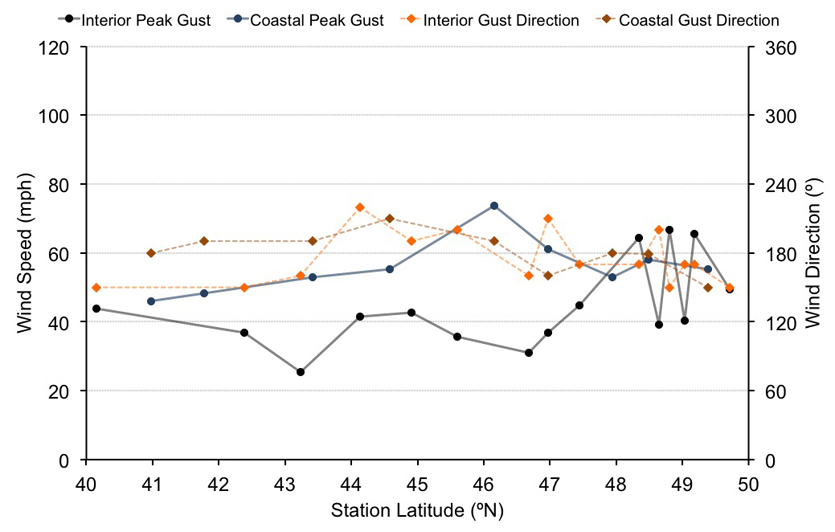
Figure 3.3 above Peak wind (mph) and peak wind direction (º) for coastal and interior stations arranged by latitude.
|
With a 24-station average peak wind of 32.7 mph (53 km/h) and average peak gust of 49.7 mph (80 km/h) from the S, the March 10, 2016 windstorm in overall terms performed about average for Northwest windstorms (Table 3.1, Figure 3.1). However, given a relatively distant track near 130ºW as the low-pressure center moved northward, the wind speeds were actually rather strong and indeed quite unusually so in some locations.
The region of intense winds on the northwest Oregon and southwest Washington coasts is reminiscent of the Great Coastal Gale of December 2007. As with the earlier storm, a coastally trapped jet contributed to the high readings. Also, as noted above, the secondary low that swung around the base of the primary appears to have helped strengthen pressure gradients in the region afflicted by the intense wind gusts. The main low of the December 2007 event also tracked through the Queen Charlotte Sound--perhaps this is a repeating pattern for extreme winds for the region from approximately Newport, OR, to Hoquiam, WA.
In the interior, winds were particularly intense north of Seattle (Figure 3.2), the standard outcome for a classic "southeast sucker" and typically the result of extratropical cyclones following tracking far from the coast. In the main strike zone, some stations were dramatically favored over others for high winds, not an entirely unusual situation among the rugged terrain of the Pacific Northwest. This is looked at more below.
Peak gusts on the coast were markedly higher than in the interior up to about the latitude of Seattle, then the situation reversed to some extent (Figure 3.3). The secondary low appears to have relaxed pressure gradients enough on the central and southern coast of Vancouver Island to prevent more extreme winds from occurring, while at the same time supporting intense southeasterly winds in the Georgia Strait and Northern Inland Waters. Northern Vancouver Island, overrun by the intense pressure gradient surrounding the core of the intense March 10, 2016 extratropical cyclone, was not spared intense winds like the southern 2/3 of the Island.
|
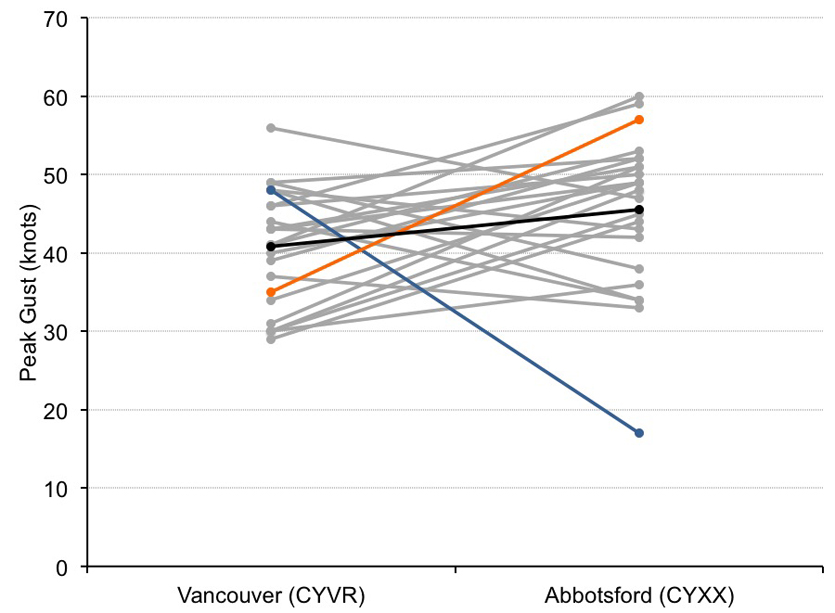
Figure 3.4 above For 24 southeasterly high windstorms that affected the Victoria, Vancouver and Abbotsford region from 1994-2015, the peak gusts (knots) at Vancouver and Abbotsford. The majority of the storms are depicted in gray to show the range of variability. The average peak gust at the two locations for all the storms is highlighted in black. The outcomes of a windstorm on November 8, 1994 and March 10, 2016 are accented in blue and orange respectively.
|
During the March 10, 2016 windstorm, Vancouver and Abbotsford reported dramatically different peak gusts, 40 mph (65 km/h) verses 66 mph (106 km/h) (Table 3.1). These two locations are just 37.6 straight-line miles (60.6 km) apart. On average, Abbotsford tends to have higher readings than Vancouver during southeasters, so the peak gust outcome on March 10, 2016 is not entirely unusual (Figure 3.4). However, this is the largest exceedance of Vancouver's peak gust for the 22 years 1994-2015. Interestingly, during southeasters, Vancouver sometimes receives stronger peak winds than Abbotsford. The "Looper Storm" of November 8, 1994 resulted in what appears to be the most dramatic difference in peak gusts between the two locations, with Vancouver being slammed by a 55 mph (89 km/h) gust while Abbotsford received a meager 20 mph (31 km/h).
I have not yet encountered a meteorologist to date that can provide a mechanism for the favoring of one station over the other during a specific storm, this despite being an important forecasting issue in the Lower Mainland. Anticipating the region to be most strongly afflicted by an incoming storm would be useful to interests such as electrical utilities, as it would allow them to strategically place damage-control assets ahead of an incoming extratropical cyclone with confidence.
As for a mechanism, my suspicion is that the favoring of one location, more often Abbotsford, has to do with the tendency of a cold surface layer sourced from the Fraser Valley to be emplaced over the Lower Mainland ahead of southeasterly windstorms. SE winds tend to arrive with warmer, more buoyant air that can simply lift right over any emplaced cold air. The resistance of the cold surface airmass to being eroded by increasing S to SE winds likely determines outcomes: Abbotsford is often affected by downsloping winds off of the Cascades during southeasters, and perhaps these winds are often strong and turbulent enough to break up the cold surface layer in the region sooner than Vancouver in many instances--this despite Abby being closer to the source of the cold, dense air. In Vancouver, the North Shore Mountains probably act as an air dam, leaving the region under a shield that directs the wind above the city. The depth of the cold surface layer, combined with the strength of the attacking SE winds, may determine to some extent how long it takes for the warm winds to reach the surface. If it takes long enough, strong SE winds may not hit Vancouver as the center of a given storm moves far enough away to relax local pressure gradients by the time the cold air layer has been removed. Sometimes the surface layer is weak, leaving both locations exposed early during an approaching storm. The pressure gradient orientation (pressure slope) ahead of the storm and during the SE wind onslaught may have a key role in outcomes, too. If E to NE winds are favored, then the cold surface layer can be continually reinforced. In contrast, if the pressure gradient orientation is more in favor of ESE to SE winds ahead of the storm, the source of the cold air may be cut off, allowing for a quicker erosion of the boundary layer. These are just ideas. This topic is just waiting for a detailed study--it would be a nice PhD project.
|
|
